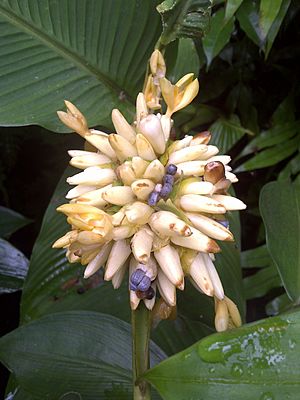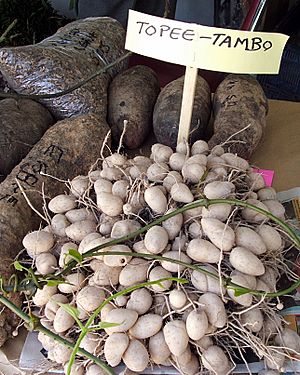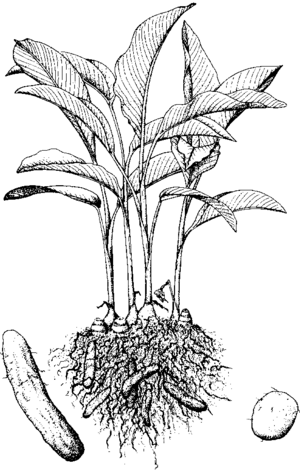Sweet corn root facts for kids
Quick facts for kids Sweet corn root |
|
|---|---|
 |
|
| Scientific classification | |
| Genus: |
Goeppertia
|
| Species: |
allouia
|
| Synonyms | |
|
|
Goeppertia allouia, often called lerén or lairén, is a plant from the arrowroot family. People also know it as Guinea arrowroot or sweet corn root in English. This plant is native to northern South America and the Caribbean. The name "allouia" comes from the Carib word for this plant. Leren is a small food crop in tropical America. It was one of the first plants grown by ancient Amerindians in South America.
Contents
Where Does Leren Grow?
Goeppertia allouia naturally grows in many places. These include Cuba, Hispaniola, Puerto Rico, and the Lesser Antilles. It is also found in Trinidad and Tobago, Venezuela, Colombia, Ecuador, Peru, and Brazil. The plant has also started growing on its own in Jamaica.
People have brought leren to other tropical areas around the world. It is grown there as a minor root crop.
What Does Leren Look Like?
Leren is a plant that lives for many years. It usually grows to be about 1 meter (39 inches) tall. This plant produces roots that are shaped like eggs. These roots are about 2 to 8 centimeters (0.8 to 3 inches) long. They grow at the end of thin, stringy roots.
The leaves of the leren plant are quite large. They can be up to 60 centimeters (24 inches) long and 20 centimeters (8 inches) wide. Long ago, Indigenous people used these strong leaves. They made traditional medicines and even baby clothing from them. Leren usually grows new plants from its rhizomes. Rhizomes are underground stems that can sprout new shoots.
How Does Leren Grow?
Leren grows best in a tropical climate. This means it likes periods of rain followed by dry seasons. The plant starts to sprout when the first rains arrive. It grows very quickly. After about eight or nine months, it forms its edible tubers. These tubers are harvested when the plant's leaves start to die.
The rhizomes are also collected at the same time. These underground stems can handle both dry and wet conditions. Farmers divide the rhizomes and plant them again when the rainy season begins. If there are dry periods, the plant needs a lot of water. Leren is often planted in shady or partly shady spots. However, it can grow in full sun if it gets enough water and nutrients.
Today, leren is usually grown on a small scale. Its cultivation is becoming less common. Other crops have taken its place.
Eating Leren

Leren tubers are usually cooked by boiling them. This takes about 15 to 60 minutes. When cooked, leren is often compared to Chinese water chestnut. This is because leren stays crunchy even after it's boiled. Boiled leren tastes a bit like sweet corn. This is why one of its English names is "sweet corn root."
The cooked tuber has a thin skin that you can eat. It's easiest to peel this skin off after cooking. Leren is mostly eaten as a small dish before a main meal, like an appetizer. You can store leren tubers at room temperature for up to three months. However, they do not do well when kept in a refrigerator.
Scientists have not studied the nutritional value of leren in great detail. But the tubers contain about 13-15 percent starch. They also have about 6.6 percent protein.
Leren in Ancient Times
Archaeologists have found that leren was one of the first plants grown by people in ancient South America. Leren was cultivated along with other plants. These included arrowroot (Maranta arundinacea), squash (Cucurbita moschata), and bottle gourd (Lagenaria siceraria). People were growing these plants in northern South America and Panama between 8200 BCE and 5600 BCE.
It seems that growing leren spread to places where it did not naturally grow. For example, people of the Las Vegas culture grew leren around 7000 BCE. They lived on the dry Santa Elena Peninsula in Ecuador. They grew leren to eat it raw, dried, or ground into flour.
Images for kids
See also
 In Spanish: Goeppertia allouia para niños
In Spanish: Goeppertia allouia para niños



